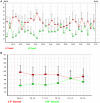Spectral Analysis of Heart Rate Variability: Time Window Matters
- PMID: 31191437
- PMCID: PMC6548839
- DOI: 10.3389/fneur.2019.00545
Spectral Analysis of Heart Rate Variability: Time Window Matters
Abstract
Spectral analysis of heart rate variability (HRV) is a valuable tool for the assessment of cardiovascular autonomic function. Fast Fourier transform and autoregressive based spectral analysis are two most commonly used approaches for HRV analysis, while new techniques such as trigonometric regressive spectral (TRS) and wavelet transform have been developed. Short-term (on ECG of several minutes) and long-term (typically on ECG of 1-24 h) HRV analyses have different advantages and disadvantages. This article reviews the characteristics of spectral HRV studies using different lengths of time windows. Short-term HRV analysis is a convenient method for the estimation of autonomic status, and can track dynamic changes of cardiac autonomic function within minutes. Long-term HRV analysis is a stable tool for assessing autonomic function, describe the autonomic function change over hours or even longer time spans, and can reliably predict prognosis. The choice of appropriate time window is essential for research of autonomic function using spectral HRV analysis.
Keywords: fast fourier tranform (FFT); heart rate variability; long-term; multiple trigonometric regressive spectral analysis; short-term; trigonometric regressive spectral analysis.
Figures


Similar articles
-
Trigonometric regressive spectral analysis: an innovative tool for evaluating the autonomic nervous system.J Neural Transm (Vienna). 2013 Sep;120 Suppl 1:S27-33. doi: 10.1007/s00702-013-1054-5. Epub 2013 Jun 28. J Neural Transm (Vienna). 2013. PMID: 23812502 Review.
-
Modulation of Cardiac Autonomic Function by Fingolimod Initiation and Predictors for Fingolimod Induced Bradycardia in Patients with Multiple Sclerosis.Front Neurosci. 2017 Oct 12;11:540. doi: 10.3389/fnins.2017.00540. eCollection 2017. Front Neurosci. 2017. PMID: 29075174 Free PMC article.
-
A methodological comparison of the Porges algorithm, fast Fourier transform, and autoregressive spectral analysis for the estimation of heart rate variability in 5-month-old infants.Psychophysiology. 2014 Jun;51(6):579-83. doi: 10.1111/psyp.12194. Epub 2014 Feb 24. Psychophysiology. 2014. PMID: 24611569
-
Comparison of fast Fourier transform and autoregressive spectral analysis for the study of heart rate variability in diabetic patients.Int J Cardiol. 2005 Oct 10;104(3):307-13. doi: 10.1016/j.ijcard.2004.12.018. Int J Cardiol. 2005. PMID: 16186061
-
[Analysis of heart rate variability. Background, method, and possible use in anesthesia].Anaesthesist. 1995 Oct;44(10):677-86. doi: 10.1007/s001010050201. Anaesthesist. 1995. PMID: 8533867 Review. German.
Cited by
-
Heart rate variability and the risk of heart failure and its subtypes in post-menopausal women: The Women's Health Initiative study.PLoS One. 2022 Oct 25;17(10):e0276585. doi: 10.1371/journal.pone.0276585. eCollection 2022. PLoS One. 2022. PMID: 36282885 Free PMC article.
-
Causal Link between Ventricular Ectopy and Concussion.Case Rep Med. 2020 Jun 3;2020:7154120. doi: 10.1155/2020/7154120. eCollection 2020. Case Rep Med. 2020. PMID: 32565823 Free PMC article.
-
Oral appliances reduce masticatory muscle activity-sleep bruxism metrics independently of changes in heart rate variability.Clin Oral Investig. 2022 Sep;26(9):5653-5662. doi: 10.1007/s00784-022-04520-y. Epub 2022 May 10. Clin Oral Investig. 2022. PMID: 35538329
-
Performance of heart rate adjusted heart rate variability for risk stratification of sudden cardiac death.BMC Cardiovasc Disord. 2023 Mar 22;23(1):144. doi: 10.1186/s12872-023-03184-0. BMC Cardiovasc Disord. 2023. PMID: 36949420 Free PMC article.
-
Application of the Lomb-Scargle Periodogram to InvestigateHeart Rate Variability during Haemodialysis.J Healthc Eng. 2020 Dec 8;2020:8862074. doi: 10.1155/2020/8862074. eCollection 2020. J Healthc Eng. 2020. PMID: 33376586 Free PMC article.
References
-
- Kuusela T. Methodological aspects of heart rate variability analysis. In: Kamath MV, Watanabe M, Upton A. editors. Heart Rate Variability (HRV) Signal Analysis: Clinical Applications. Boca Raton, FL: CRC Press; (2013). p. 9–42. 10.1201/b12756-4 - DOI
LinkOut - more resources
Full Text Sources
Other Literature Sources

